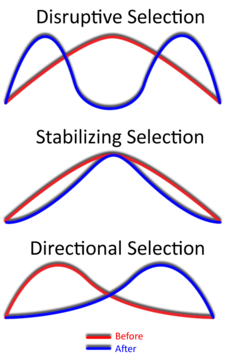- Disruptive selection
-
Disruptive selection, also called diversifying selection, describes changes in population genetics in which extreme values for a trait are favored over intermediate values. In this case, the variance of the trait increases and the population is divided into two distinct groups.[1][2] This evolutionary process is believed to be the driving force behind sympatric speciation.[citation needed]
Contents
Example
Suppose there is a population of rabbits. The color of the rabbits is governed by two incompletely dominant traits: black fur represented by “B” and white fur represented by “b”. A rabbit with the genotype of “BB” would have a phenotype of black fur, a genotype of “Bb” would have grey fur (a display of both black and white) and a genotype of “bb” would have a phenotype of white fur.
If this population of rabbits were put into an area that had very dark black rocks as well as very white colored stone, the rabbits with black fur would be able to hide from predators amongst the black rocks and the white furred rabbits would be able to hide in the white rocks, but the grey furred rabbits would stand out in both of the habitats and would suffer greater predation.
As a consequence of the selective pressures of their environment, our hypothetical rabbit population would be disruptively selected for extreme values of the fur color trait: white or black, but not grey.
Significance
Disruptive selection is of particular significance in the history of evolutionary study, as it is involved in one of evolution's "cardinal cases", namely the finch populations observed by Darwin in the Galápagos.
He observed that the species of finches were similar enough to ostensibly have been descended from a single species. However, they exhibited disruptive variation in beak size. This variation appeared to be adaptively related to the seed size available on the respective islands (big beaks for big seeds, small beaks for small seeds). Medium beaks had difficulty retrieving small seeds and were also not tough enough for the bigger seeds, and were hence maladaptive.
While it is true that disruptive selection can lead to speciation, this is not as quick or straightforward of a process as other types of speciation or evolutionary change. This is largely because the results of disruptive selection are less stable than the results of directional selection (directional selection favours individuals at only one end of the spectrum).
For example, let us take the mathematically straightforward yet biologically improbable case of the rabbits: Suppose directional selection were taking place. The field only has dark rocks in it, so the darker the rabbit, the better. Eventually there will be a lot of black rabbits in the population (hence lots of “B” alleles) and a lesser amount of gray rabbits (who contribute 50% chromosomes with “B” allele and 50% chromosomes with “b” allele to the population). There will be few white rabbits (not very many contributors of chromosomes with “b” allele to the population). This could eventually lead to a situation in which chromosomes with “b” allele die out, making black the only possible colour for all subsequent rabbits. The reason for this is that there is nothing "boosting" the level of “b” chromosomes in the population. They can only go down, and eventually die out.
Consider now the case of disruptive selection. The result is equal numbers of black and white rabbits, and hence equal numbers of chromosomes with “B” or “b” allele, still floating around in that population. Every time a white rabbit mates with a black one, only gray rabbits results. So, in order for the results to "click", there needs to be a force causing white rabbits to choose other white rabbits, and black rabbits to choose other black ones. In the case of the finches, this "force" was geographic/niche isolation.
See also
- Character displacement
- Balancing selection
- Directional selection
- Negative selection (natural selection)
- Stabilizing selection
- Sympatric speciation
References
- ^ Sinervo, Barry. 1997. Disruptive Selection [1] in Adaptation and Selection. 13 April 2010.
- ^ Lemmon, Alan R. 2000. EvoTutor. Natural Selection: Modes of Selection [2]. 13 April 2010.
Natural selection Balancing selection · Directional selection · Disruptive selection · Negative selection · Stabilizing selection · Selective sweepModels Molecular processes Categories:
Wikimedia Foundation. 2010.

